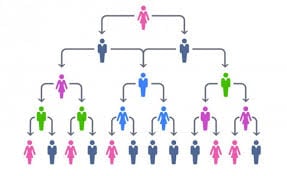Hierarchical Structure vs Flat Structure? A very common debate when the decision to govern an organization comes up. Each of these structures has their own advantage and disadvantage.
The most appropriate use of these structures would be to assess the needs and wants of the organization keeping goal set in view. This can help understand the requirements better.
A proper route to decision making can help solve the Hierarchical Structure vs Flat Structure debate for any organization.
Jump to Matrix Structure, Network Structure, Functional Structure, or Divisional Structure.
Table of Contents
The Flat Structure

The flat organizational structure eliminates middle management and adopts a more casual, people-powered approach to running a business. Small organizations, naturally adopt this structure because of limited employees.
The lower number of employees who are focused helps in ensuring that the business is able to manage without complicating things for the organization. When the businesses start growing with a lot of additions however there is a need to adopt a formal structure.
The growth can be in the form of diversification of products, business functionalities and furthermore even geographic growth.
The major problem that businesses adopting a flatter structure face is in terms of growth. As being able to manage a higher number of employees and maintaining their product quality can be challenging.
A larger organization would mean a higher number of employees due to which there can be an increase in misunderstandings because of lack of communication. It can consequently affect the decision-making process.
The Hierarchical Structure

A hierarchical organizational structure link employees either indirectly or directly, vertically or horizontally. The only direct connection in such organizations is between the one working with whom you are working or your immediate manager.
As a result of which, the hierarchy may or may not have people linking vertically, but due to the same level of communication, there can be some linkage. Hierarchical organizational structures have multiple tiers, and these tiers usually have different layers of management in between. In such organizations, there are often a particular group of employees working under a single manager.
Consequently, this results in a better manager-employee relationship. A worker is reporting to a single manager, and therefore there are no clashes or confusions. Close monitoring and better management of the employee performance are part and parcel of the hierarchical structure.
Above all, the hierarchical structure encourages employees to focus on organizational goals rather than personal ones.
Hierarchical Structure vs Flat Structure
Hierarchical Structure vs Flat Structure can only be understood when compared to the same metrics. Below is a comparison between the two structures.
Pros and Cons of Flat Organizational Structure
PRO: Decision making
Decision making is quite simple and easy in a flat organization. There is no tall structures to climb through and hence ultimately the decision making is quick. The communication is fast and hence decision making happens within a short time frame.
PRO: Communication
The coordination and speed of communication between employees are quick. This means that the flow of instructions throughout the organization is timely without any deliberate or unintentional delays. This ultimately leads to prompt decision making.
PRO: Resistance to Change
The flat organization usually have lesser number of employees. The organization has a perfect communication channel with no barriers and this leads to better adaption and resilience within the organization as a whole. The key to making change possible is to be able to take employees on board.
CON: Productivity
In a flat organization, the employees tend to find it difficult to manage workload. It is very popular for an organization with a flat structure to have generalists rather than specialists. As a result of the increased workload, the employee may find it difficult to manage hence weak performance.
CON: Clarity of Managerial control
Many of the employees in a flat organization are reporting to more than one managers at once. Consequently, this can result in a staggering amount of pressure on the worker. Also, since the employee is reporting to multiple managers at once the line of managerial control is a blur and hence lack clarity. This can also lead to confusion of job roles. It can also lead to power tussle between popular managers.
CON: Employee-Manager relation
The employee is reporting to multiple managers at a time and this can lead to greater confusion amongst the employee. The power tussle between managers and the pleasing attempts on the part of the employees can create odd dynamics within the organization. This gives rise to an air of mistrust amongst the employees and ultimately affect their performance.
CON: Organizational growth
Managing a larger number of employees in a flat organization is a very challenging task, at which the majority fail. Thus, organizations with flat organizational structure have limited growth opportunities.
Pros and Cons of Hierarchical Organizational Structure
PRO: Productivity
In a Hierarchical organizational, the workload is easily manageable by the employees. There are set targets and goal setting which ultimately allows the employees to prioritize their work as they need to report to a single manager.
PRO: Clarity of Managerial control
In a Hierarchical organizational, a group of employees is reporting to a certain manager alone. There is no criss-cross line of management. The proper predefined line of managerial control eliminates the possibility of any confusion, hence a more controlled work environment.
PRO: Employee-Manager relation
The employee is reporting to a single manager. Furthermore, the only thing that an employee has to worry about is to meet the targets. The employee-manager relationship in a Hierarchical organizational is usually one to one and hence a much better work environment.
PRO: Organizational growth
The organization has no limit to growth. Their Hierarchical structure allows them the opportunity to grow as they certainly need not worry about the division of tasks or maintaining synchronicity within their organization.
CON: Decision making
Decision making takes a lot of time in a Hierarchical organizational. There are lots of managerial levels that the decision has to pass to be able to get approval.
CON: Communication
Communication is quite a lengthy process for the Hierarchical organizational because there are lots of different levels that the information passes through. Transparency within the information being circulated is the key because lack of which can cause lots of losses to the organization.
CON: Resistance to Change
The Hierarchical organizational faces lots of resistance if they are implementing change. A combination of change management techniques needs to be employed to ensure a smooth process. Communicating is the key to a balanced change.
Last modified: July 8, 2025




